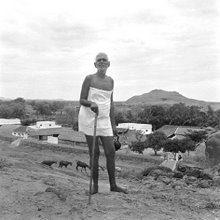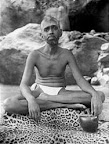"WHEN Ganapati said, "Mother is mine" and sat on the lap of Parvati, Kumara retorted, "Never mind, Father is mine" and got on to Siva's lap and was kissed by him on the head. Of this Kumara who pierced (with his lance) the Krauncha hill, Ramana is a glorious manifestation."
— Ramana Gita. 18.9
AROUND March 1899, the Swami left Pavalakundru and ascended Arunachala. It is entirely appropriate that the son who abides in Reality should get on to the lap of his Father in his natural state!
Legend has it that Easwara resided in Arunachala in four forms. The first was the dazzling form without a beginning or an end causing amazement to Brahma and Vishnu, the second was the linga form of Arunachaleswara, the third Arunagiri and the fourth Arunagiri yogi in siddha [?] form.
Arunachala is of brilliant light, yet it appears in brick red colour as a stone with not much of vegetation. The hill is noted to be very ancient originating much earlier than the Himalayas.
It is said by geologists that the hill was formed during the period when the earth, then a ball of fire, was cooling
down and solidifying as stone and that it was part of the Lemuria which submerged in the Indian Ocean. For this reason it would appear that this hill is at the centre of the earth as mentioned by the puranas.
For those interested in performing penance, the hill offers many suitable places. Standing behind the western tower of the Arunachala Temple one notices a path to the top of the hill. While climbing along this path one may observe several caves, shrines and the like suitable for performing meditation. One occasionally comes across springs of fresh mineral water sparkling in the rays of the sun like liquid gold and making rumbling noises like musical notes. Along this path are several trees which give ample shade, the groves also are good places for tapas [?]. As one ascends the hill and heads towards the east one beholds the Arunachala Temple and to its east, the town. To the east of the town lies the Ayyankulam tank (also known as Indra [?] teertham). Surrounding the tank one notices fields and orchards, at the distant horizon are rows of hills bringing together the earth and the sky-all of which provide a picturesque setting. Therefore, those not of a particularly religious bent of mind also ascend the hill to witness the splendour of nature, obtain relief from daily cares and get peace and happiness. Those with an other-worldly attitude look at that personification of Easwara and either sing its praise or fall into meditation and obtain peace.
SADGURUSWAMI CAVE:
Near the foot of the hill lies a cave. Though in a dilapidated state, during the period under consideration
some people stayed there. A Malayali Yogi lived there at one time and in his memory, his disciples began describing the cave as Sadguru Swami cave. There is a temple a little above the cave. Actually it is also a cave but people use it as a temple. It is known as Guha Namasivaya Temple after Guha Namasivaya, a Veerasaiva devotee, belonging to Srisailam. Both he and Virupaksha Deva, another devotee, reached Arunachala and settled in these caves; hence the caves are named after them.
VIRUPAKSHA CAVE:
This most important cave on the mountain is further up. Its shape resembles the syllable "Om" and it is said that as the wind enters the cave, the sound "Om" becomes audible. Close to the cave is a water spring. The samadhi of Virupaksha is there. Those following the Veerasaiva creed ran a math [?] there. At about the commencement of the twentieth century a law suit was going on and neither of the contending parties bothered about the math [?]. Hence anyone could stay there without any hindrance. This became the Swami's residence until he left for Skandasramam in 1915-1916.
Years after the Swami settled down at Virupaksha cave the question of ownership of the math [?] was settled by the court. The head of the math [?] in whose favour it was decreed appointed an agent, whose meagre income was from the donations of the visitors to the math [?]. But he hit upon the idea of collecting a fee from visitors during Krittikai. Many could not pay this fee and went back. The Swami got to know this and felt that those who
wished to have his darshan were being unfairly taxed. He therefore left the cave and sat beneath a tamarind tree opposite the cave. But the agent began levying the fee even on the approach to the tree. The Swami came to know about this and as he had no compelling reasons to reside there, moved to Guhanamassivaya cave. The agent then realised that the visitors came to have a darshan of the Swami and not to see the cave or the math [?]. Having done so, he begged of the Swami to reside at the Virupaksha cave which he did.
MULAIPAL TEERTHAM, MANGO TREE CAVE (CHUTHAGUHA):
Opposite the Virupaksha cave towards the north, was the Mulaipal teertham. (milk spring) which always had copious sweet water. Legend has it that the water at Guhanamassivaya cave sprang from the big toe of Siva and that this spring arose from the breast of Ambika. Near this was a mango tree at the foot of which arose a cave. Hence it came to be known as Mango tree cave. During summer months at the Virupaksha cave, there was no breeze and no water and as the place was pretty warm, two devotees, Ramanujacharya and Rangacharya modified the Mango tree cave and made it habitable for the Swami during the summer.
SKANDASRAMAM:
Further up beyond the Virupaksha cave was a perennial spring — with clear, sweet water. The Swami's devotees felt it could serve as a residence for him. In 1915-1916 they cleaned and levelled the ground and built a house with trees all round. The coconut and
mango trees provided a picturesque setting and any beholder was pleased at its sight. It was as if it was the heart of Arunachala. The building had a kitchen and a living area with a verandah in front. The devotee who started it all was Kandaswami. The ashram came to be known as Skandasramam because of the disciple and the belief of several devotees that the Swami was an incarnation of Skanda.
Wherever he stayed there was no dearth of food for the Swami. The increasing numbers of devotees were always anxious to fetch and offer food to him wherever he stayed. If it became inevitable, Palaniswami, the faithful attendant, went into the town and begged for food. Palaniswami was joined by some others who were eager to serve the Swami, one among them would go into the town and collect food.
Referred Resources:
Links to letters:
Links to rl:
Ramana Gita: (Chapter 27: Sri Ramana Gita
Palaniswami: (Chapter 15: Yoga Siddhi
Ayyankulam: (Chapter 11: The Goal
1915: (Chapter 27: Sri Ramana Gita
Links to sp:
Links to gems:





No comments:
Post a Comment